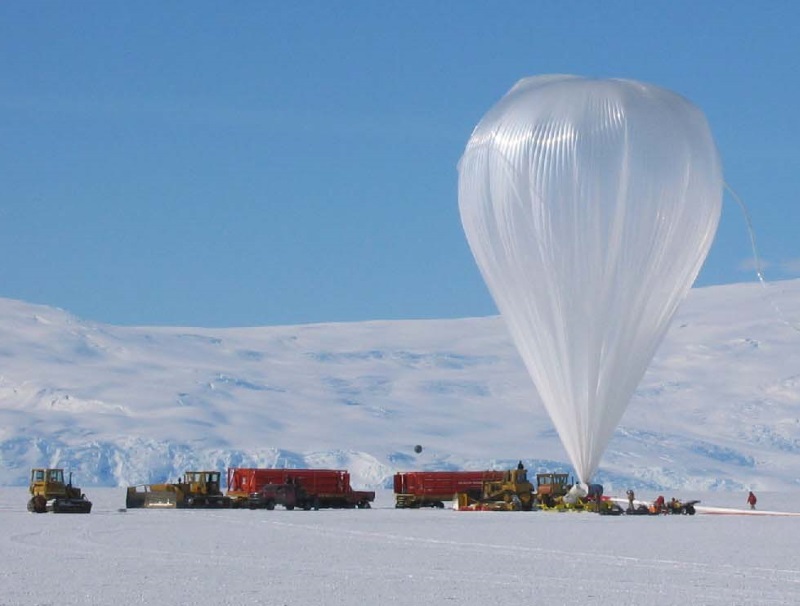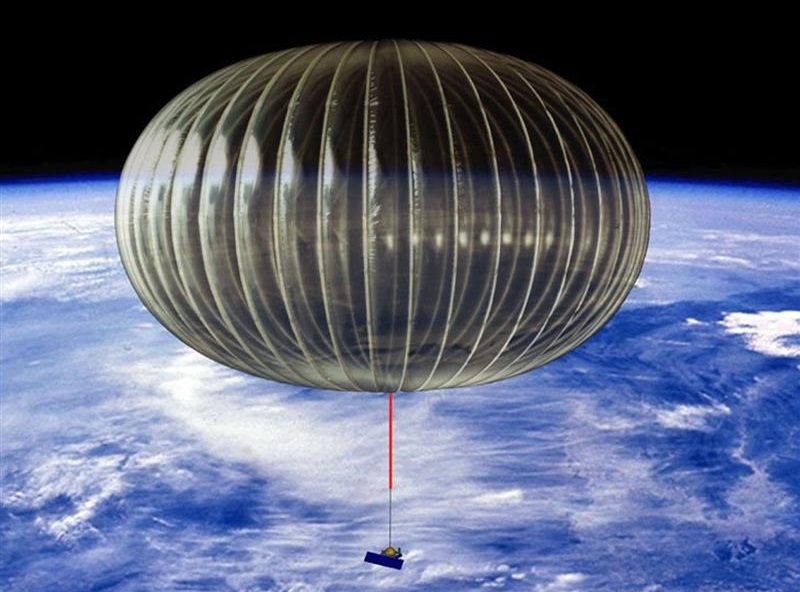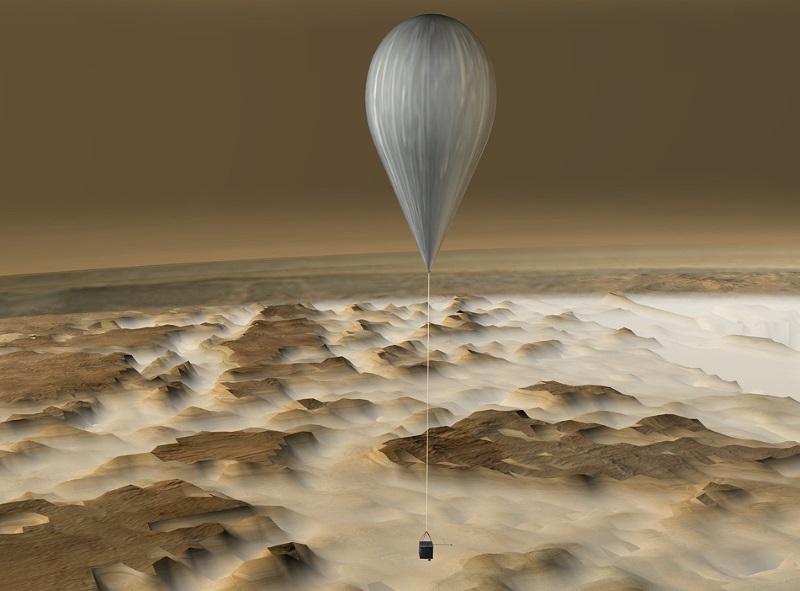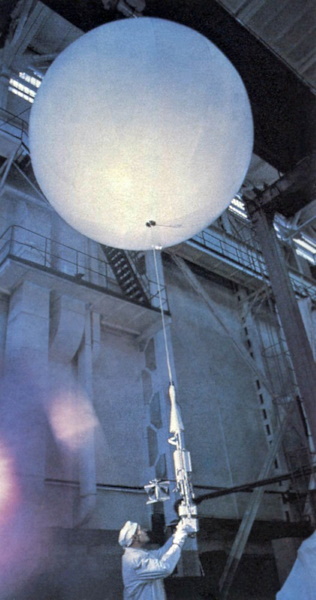
* While the "great age" of manned balloon flights into the stratosphere is history, balloons continue to be important tools for scientific research. Unmanned stratospheric balloons are used for astronomy and climate studies, and balloons are also potentially an important tool for exploring other planets.
* Although crewed high-altitude scientific ballooning died out in the 1960s, high-altitude autonomous balloon research remains alive and well, with the US a leader in the effort. The US Air Force never really abandoned autonomous high-altitude balloons, with the Air Force Research Lab currently conducting about a half-dozen flights a year from the municipal airports at Santa Rosa, New Mexico, and Holbrook, Arizona. The tests are apparently focused on development of aerospace technologies, not pure science research.
The US National Aeronautics & Space Administration (NASA) conducts a more ambitious program, focused primarily on scientific research. The NASA effort has its roots in a scientific balloon program set up by the US National Science Foundation in 1961, originally based in Boulder, Colorado. In 1963, the balloon program was moved to Palestine, Texas, halfway between Dallas and Houston, since at the time the area was largely unpopulated and balloon payloads falling out of the sky were unlikely to land on a house. NASA picked up the balloon program in 1982. The Palestine operation now designated the "Columbia Scientific Balloon Facility (CSBF)" -- the name having been changed from the "National Scientific Balloon Facility" in 2005 in honor of the crew of the space shuttle Columbia, which burned up on reentry in 2003.
The CSBF is directed by the Physical Sciences Laboratory of New Mexico State University at Las Cruces. However, population growth near Palestine has forced the CSBF to perform more launches at remote sites. Launches are regularly performed at Fort Sumner, New Mexico; Lynn Lake, Manitoba, Canada; McMurdo Station, Antarctica; Fairbanks, Alaska; Alice Springs, Australia; and Kiruna, Sweden. Special launches have also been performed from a number of other locales.
The CSBF has performed over 2,000 balloon flights since its inception. At its peak, in the 1970s, the CSBF was performing up to 80 missions a year, but the organization's launch rate is now much lower, a few dozen missions a year. Partly this is because the easy, cheap missions have mostly been done, but it is also due to funding limitations. However, the CSBF is not in danger of extinction, since researchers know that it is much easier, quicker, and cheaper to use a balloon than a spacecraft to fly a payload into near-space conditions. The fact that balloon payloads, unlike satellite payloads, are usually recovered intact for re-use is another plus.

* The zero-pressure balloon used by the CSBF is generally similar to the SKYHOOK balloons originally invented by Winzen. It is made from special polyethylene film, typically 0.8 mil thick, fabricated from longitudinal panels sealed with tapes. A scientific balloon typically has a volume of 1.08 million cubic meters (38 million cubic feet) and can carry 1,700 kilograms (3,750 pounds) of suspended load to 39 kilometers (128,000 feet). At that altitude, the scientific payload is above 99.7% of the atmosphere's mass.
The flight train consists of the balloon and a scientific instrument package, hitched to the balloon through a parachute pack. A NASA zero-pressure science balloon is inflated through the traditional roller system, with enough lifting gas provided for 10% lift over the load and balloon mass, and the gas expanding as the balloon rises.
Data from the payload and balloon are telemetered directly to ground stations or through satellite links. Occasionally they are also recorded on board via film, magnetic tape, or solid-state digital storage media. Radio commands are used for instrument and balloon control. Balloon position is obtained by direct visual tracking, airplane tracking, or use of Global Position System (GPS) navigation receivers. The flight ends when the parachute and payload are separated via radio command, usually from a tracking aircraft. During separation, the balloon is destroyed by tearing open a set of rip panels, permitting the payload to parachute to the ground.
Improvements in design, materials, and quality control have made the large zero-pressure balloon an extremely reliable vehicle, with very high mission success rates. While long-standing studies on cosmic rays, atmospheric circulation, and weather continue, much recent effort has been devoted to the atmospheric chemistry, and to astronomy at wavelengths -- such as the infrared, ultraviolet, and X-ray bands -- that are blocked by the atmosphere.
* Along with flying zero-pressure balloons, the CSBF has been a pioneer in work on long-endurance superpressure / pumpkin balloons, having spent decades flying what they call "Ultra-Long Duration Balloons (ULDB)", working with Raven Aerostar. Raven conducted a flight of a prototype ULDB in October 1999, but the balloon ruptured when it reached altitude. A second prototype, a tenth the size of a full-scale ULDB, was launched in June 2000 and was a success, remaining aloft for 27 hours.

The full-scale ULDB design features an envelope with an inflated diameter of 59 meters (193 feet) and height of 35 meters (115 feet). It is intended to remain aloft with 900 kilograms (a ton) of payload at altitudes of 35 kilometers (115,000 feet) for up to 100 days. The first full-scale ULDB test flight took place in late February 2001 from an Alice Springs, Australia, launch site, but sprung a leak and was destroyed a few hours after launch.
There were more flights up to 2015, when Wanaka, New Zealand, became the preferred site for ULDB flights, with launches in 2015, 2016, and 2017. A ULDB flight in 2016 set a record of 46 days, which was still only half of the expected flight duration. From 2017, the ULDB effort then stalled, due to various issues -- a global pandemic being a big one, with travel to New Zealand curtailed -- contributing to delays.
Efforts to launch in 2022 ran into difficulties, but in 2023 a ULDB was successfully launched from Wanaka carrying the "Superpressure Balloon-borne Imaging Telescope (SuperBIT)". SuperBIT -- developed by Durham, Toronto, and Princeton Universities in the UK, Canada, and the US respectively -- has a mirror 50 centimeters (20 inches) in diameter, with the telescope used to perform deep-space observations. Mission cost is only $5 million USD, a fraction of what a comparable space telescope would cost.
* NASA's balloon program has been very successful, so much so that it has spawned commercial competitors. World View Enterprises INC of Tucson, Arizona, was founded in 2013 with the intent of flying rich tourists in zero-pressure balloons to near-space; they would float in a capsule with two crew and six passengers, with the capsule being recovered by parasail. One of the company's first projects was to support Alan Eustace in his 2014 record parachute jump.
However, company officials were soon getting calls from scientific organizations with requests to fly payloads. That seemed puzzling, since NASA was doing that job; but callers said NASA's prices were too high and the lead times too long, meaning there was an opening for a commercial operation that could fly balloons more cheaply and quickly.
The company is developing automated steerable balloons, powered by a solar array hung between the envelope and the gondola. The flight control system pumps helium between the envelope and a reservoir to make the balloon sink or rise, exploiting the different persistent stratospheric wind directions at different altitudes. Company officials envision their stratolites as platforms to provide warning of flash floods or wildfires; to sense the soil and vegetation with laser scanners and imagers; to probe winds, clouds, and storms with radars; and to conduct traditional science balloon astronomy missions. World View has had no shortage of customer interest. There appears to be military interest in World View's balloons, just as certainly as there is civil interest in Raven Aerostar's balloons.
World View lost focus on high-altitude balloon tourism, spinning off a separate company named "Space Perspective" in 2020 to continue on that track. Initial flights for paying customers, at last notice, were scheduled for 2025. NASA is encouraging the commercial ballooning industry, though with cautions that safety will need to be a fundamental consideration in operations.
* Incidentally, there's considerable activity in small science balloons or "microballoons / picoballoons", flown by schools and hobby clubs. In the USA, such activities are centered around "Edge of Space Sciences (EOSS)", a nonprofit out of Denver, Colorado, with EOSS conducting flights and coordinating flights by other groups. There's also a commercial firm in Denver named "Urban Sky" that flies microballoons with small remote sensing payloads.
BACK_TO_TOP* The French, having invented the balloon to begin with, continue to make use of it for scientific research. The balloon program is run by the French CNES space agency and CNRS national scientific research agency, with funding at a level equivalent to several million USD annually. The balloon effort, named "Programme Nationale de Chimie Atmospherique (PNCA)", is focused on understanding the chemistry of the upper atmosphere, particularly mechanisms of ozone depletion.
As with US science balloons, balloons are attractive to French researchers because they are relatively inexpensive, allow missions to be launched on short notice, and allow sampling over a range of altitudes. The French balloon effort has been expanding its scope in the last few years, with missions performed from Arctic and tropical locales, in cooperation with foreign partners and in coordination with ground or sea station, aircraft, and spacecraft measurements.
Some of the PNCA flights have tested infrared (IR) montgolfieres and studied their suitability for Arctic stratospheric research. These balloons are 40 meters (130 feet) in diameter, and have an aluminized mylar outer top shell along with a transparent polyethylene bottom shell. The bottom shell is designed to absorb infrared radiation from the ground and clouds during the night, allowing it to stay afloat without having to dump ballast. Early tests of the IR balloons in Ecuador and South Africa demonstrated that each could carry a payload of 50 kilograms (110 pounds) for more than 60 days. A comparable open stratospheric balloon can only operate for about a day. The IR balloons cost about three times as much, but their improved capabilities make them worth the additional cost.
The French have long been interested in superpressure balloons, having collaborated with the US on the pioneering GHOST programs -- though the French called their similar small superpressure balloons "Eole", after the Greek god of the wind. The modern PNCA flights have also tested superpressure balloons, designed by CNES and built by Zodiac Espace. The design is derived from the Eole SPBs, scaled up to 10 meters (33 feet). They can carry a 15-kilogram (33-pound) payload.
European researchers are now working on cheaper and smaller instruments to support these balloon programs and related research projects. Some are being financed by the European Environmental Program, others by individual European states. To support an expanded range of activities, CNES/CNRS is also working to set up balloon ranges in equatorial regions such as Brazil and India, and set up additional ranges in European countries such as Spain.
BACK_TO_TOP* Balloons have proven very useful for scientific research on Earth; there are those who believe they are potentially very useful for exploring other planets as well. Robot "rovers" have been sent to the Moon and Mars since the 1960s, but such machines tend to be expensive and have limited range, and due to the long communications timelag over interplanetary distances, they have to be smart enough to navigate without running into obstacles or falling off cliffs. If a planet has an atmosphere, however, a balloon would have many advantages over a rover.
A robot balloon, or "aerobot", would be much cheaper and lighter than a rover, with the light weight reducing booster launch costs. An aerobot could cover a great deal of ground, and its view from a height would give them the ability to examine wide swathes of terrain with far more detail than would be obtained by an orbiting satellite. For exploratory missions, the aerobot's relative lack of directional control would not be a big concern, since there would generally no need to direct it to a specific location.

Balloon designs for possible planetary missions have been unconventional. IR montgolfieres are an attractive configuration, since they can be easier to deploy than a light gas balloon; do not necessarily require a tank of light gas for inflation, instead being filled with warmed-up atmospheric gases for lift; and are relatively forgiving of small leaks. They will tend to drop to the ground when the Sun goes down, but as is explained below, that isn't completely a disadvantage.
A more unusual design that has been considered is the "reversible fluid" balloon. This type of balloon consists of an envelope connected to a reservoir, with the reservoir containing a fluid that is easily vaporized. The balloon can be made to rise by vaporizing the fluid into gas, and can be made to sink by condensing the gas back into fluid. There are a number of different ways of implementing this scheme, but basic principles are the same for all of them.
A balloon designed for planetary exploration would carry a small gondola containing an instrument payload. The gondola would also feature power, control, and communications subsystems. Due to weight and power supply constraints, the communications subsystem will generally be small and low powered, with interplanetary communications relayed through an orbiting planetary probe.
An IR montgolfiere will sink at night, with a guide rope attached to the bottom of the gondola that curls up on the ground to anchor the balloon during the darkness hours. The guide rope would be made of low-friction materials to keep it from catching or tangling on ground features. Alternatively, a balloon might carry a thicker instrumented "snake" in place of the gondola and guide rope, combining the functions of the two. A snake is a convenient scheme for performing direct surface measurements.
One of the trickier aspects of planetary balloon operations is dropping the balloon into a planet's atmosphere and then setting it adrift. In typical scenarios, the balloon enters the planetary atmosphere in an "aeroshell", a heat shield in the shape of a flattened cone. After atmospheric entry, a parachute will extract the balloon assembly from the aeroshell, which falls away. The balloon assembly then deploys and inflates.
Once operational, the aerobot will be largely on its own and will have to conduct its mission autonomously, accepting only general commands over its long communications link to Earth. The aerobot will have to determine its position in three dimensions, possibly using an orbiting satellite as a navigation reference as well as a communications relay; acquire and store science data; perform flight control by varying its altitude; and possibly make landings at specific sites to perform close-up investigations.
BACK_TO_TOP* The first, and so far only, planetary balloon mission was performed by the Russian space agency IKI in cooperation with the French space agency CNES in 1985. A small balloon, similar in appearance to Earthly weather balloons, was carried on each of the two Soviet VEGA Venus probes, launched in 1984. The first balloon was inserted into the atmosphere of Venus on 11 June 1985, followed by the second balloon on 15 June 1985. Each balloon operated for a little under two Earth days, until the batteries ran down.

The Venus VEGA balloons were the idea of Jacques Blamont, then chief scientist for CNES and the father of planetary balloon exploration. He energetically promoted the concept and enlisted international support for the small project. The balloons were spherical superpressure types with a diameter of 3.54 meters (11 feet 7 inches), filled with helium. Each hauled a gondola with a weight of 6.9 kilograms (15.2 pounds). The gondola carried batteries, a radio transmitter system, and an instrument suite consisting of:
The entire balloon system had a weight of only about 21 kilograms (46.3 pounds).
The small low-power transmitter only provided a data transmission rate of 2,048 bits per second, though the system performed data compression to squeeze more information through the narrow bandwidth. The bandwidth was adequate, since the sampling rate for most of the instruments was only once every 75 seconds. The balloons were tracked by an international network of 20 radio telescopes back on Earth.
The balloons were dropped onto the planet's night side and deployed at an altitude of about 50 kilometers (31 miles); they then floated upward a few kilometers to their equilibrium altitude. At that altitude, pressure and temperature conditions of Venus are similar to those of Earth, though the planet's winds move at hurricane velocity and the carbon-dioxide atmosphere is laced with sulfuric acid, along with smaller concentrations of hydrochloric and hydrofluoric acid. The balloons flew swiftly across the night side of the planet into the day side, where their batteries finally ran down and contact was lost. Tracking indicated that the motion of the balloons included a surprising vertical component, revealing up-and-down circulations of air masses that had not been detected by earlier probe missions.
The scientific results of the Venus VEGA probes were modest, but the clever and simple experiment demonstrated the validity of using balloons for planetary exploration.
* After the success of the Venus VEGA balloons, Blamont focused on a more ambitious balloon mission to Mars, to be carried on a Soviet space probe. The atmospheric pressure on Mars is about 150 times less than that of Earth, though the gravity is only about a third that of Earth. Under such conditions, a balloon with a volume of 5,000 to 10,000 cubic meters (178,500 to 357,000 cubic feet) could carry a payload of 20 kilograms (44 pounds), while a balloon with a volume of 100,000 cubic meters (3,570,000 cubic feet) could carry 200 kilograms (440 pounds).
Early concepts for the Mars balloon featured a rozier dual balloon system, with a sealed hydrogen or helium-filled balloon tethered to a solar montgolfiere. The light-gas balloon component was designed to keep the montgolfiere off the ground at night; during the day, the Sun would heat up the montgolfiere, causing the balloon assembly to rise. Eventually, the group decided on a cylindrical sealed helium balloon with an envelope made of mylar, and with a volume of 5,500 cubic meters (196,000 cubic feet). The balloon would rise when heated during the day and sink as it cooled at night.
Total mass of the balloon assembly was 65 kilograms (143 pounds), with a 15 kilogram (33 pound) gondola and a 13.5 kilogram (30 pound) instrumented guide rope. The balloon was expected to operate for ten days. Unfortunately, although considerable development work was performed on the balloon and its subsystems, Russian financial difficulties pushed the Mars probe out from 1992; then to 1994; and then to 1996. The Mars balloon was dropped from the project due to cost constraints, and the probe was lost on launch in 1996 anyway.
Interest in aerial exploration of Mars has moved on to helicopters, with the "Ingenuity" demonstration helicopter deployed on the surface of Mars by the "Mars 2020" lander in 2021. It had two cameras for navigation and observation, but no other instruments.
BACK_TO_TOP* While the French were working on planetary aerobots, NASA's Jet Propulsion Laboratory (JPL) had become interested in the idea as well, with a JPL team performing several balloon test flights in the Earth's atmosphere during the 1990s. The JPL team envisioned a simple "Mars weather balloon" to validate the technology operationally; to be followed by a large superpressure balloon flight; and finally a solar-powered Mars blimp. A company named Global Aerospace Corporation performed an investigation of a Mars aerobot for NASA, with the aerobot envisioned as carrying both a science gondola and a set of small drop probes that could be released to provide detailed inspection of a number of sites.
JPL has also considered concepts for aerobots to explore planets other than Mars. One Venus aerobot concept involved a balloon that would drop surface probes. Another Venus aerobot concept involved a reversible-fluid balloon, filled with helium and water, that could occasionally drop to the surface of Venus to pick up samples, with the balloon rising to the heights again and launching the samples on a small rocket for pickup by a orbiter and transfer back to Earth. The high pressures and temperatures near the surface, as well as the sulfuric-acid-laced clouds of Venus, makes this a challenging idea. There's also been investigation of the use of acoustic sensing by balloons to monitor seismic activity on the Venusian surface; it would seem a lidar -- laser radar -- sounder might be useful as well.
More recently, researchers at the NASA Langley center in Virginia have tinkered with the concept of an airship with a crew of two, the scheme being designated the "High Altitude Venus Operational Concept (HAVOC)". Under HAVOC, a robot airship would be sent as a precursor mission, followed by a crewed mission. The crewed airship would be dispatched on one spacecraft, with the crew on another, with two crew riding the airship down into the Venusian atmosphere for deployment. They would remain above the clouds, where the temperature and pressure are relatively benign, dropping probes to the surface that might include tele-operated systems.
When done with the mission, the crew component of the airship would boost into Venus orbit, to rendezvous with the orbiting spacecraft for a voyage back home. The idea is interesting -- it is easier to get to Venus than to Mars -- but it is not entirely clear how much advantage it would have over performing tele-operated studies from Venus orbit.
Titan, the largest moon of Saturn, is an attractive target for an aerobot mission, since it has a nitrogen atmosphere twice as dense as Earth's atmosphere that contains a smog of organic photochemicals, hiding the moon's surface from view by visual sensors. An aerobot would be able to penetrate this haze to study the moon's mysterious surface and search for complex organic molecules.
JPL's concepts for a Titan aerobot have included a hydrogen balloon, with the hydrogen extracted from methane in Titan's atmosphere; a superpressure balloon that would drift until it found an interesting site and then vent itself to drop a payload onto the moon's surface; a reversible-fluid balloon that would be able to travel from site to site; and a montgolfiere balloon. There's also been consideration of airships for Titan exploration -- though, as with Mars, the drift these days is towards a helicopter probe, the Titan helicopter being named "Dragonfly". It would be powered by a radioisotope thermoelectric generator (RTG); solar power would not be possible at Saturn's distance and under Titan's smog, and batteries would not provide adequate power storage. Since Titan's gravity is only about a seventh that of Earth's, Dragonfly would be able to carry the RTG and an instrument payload.
* Finally, JPL considered aerobots to explore the atmosphere of Jupiter and possibly the other gaseous outer planets. Since the atmospheres of these planets are largely composed of hydrogen, the lightest gas, such an aerobot would necessarily be a montgolfiere. Sunlight is weak at such distances, and so the aerobot would obtain most of its heating from infrared energy radiated by the planet below.
A Jupiter aerobot might operate at altitudes where the air pressure ranges from one to ten atmospheres, occasionally dropping lower for detailed studies. It would make atmospheric measurements and return imagery and remote sensing of weather phenomena, such as Jupiter's Great Red Spot. A Jupiter aerobot might also drop sondes deep into the atmosphere, with the sondes relaying their data back to an orbiter until they were destroyed by temperature and pressure.
BACK_TO_TOP* As with many of my documents, I have no special interest in this subject. I saw a documentary on the US History Channel on the history of balloons and took some notes from it that eventually I fleshed out into this document. Ironically, most of the original notes were written out in the process.
I have never ridden in a balloon. It sounds like something worth doing, but not worth going out of my way to do. My major interest in ballooning is in applications. It is intriguing to find out just how much life there is in such an old and essentially simple technology; who would think of flying balloons on Mars? The subject also touches on my somewhat greater interest in airships. Eventually I will write a companion document on that subject as well.
When I think of balloons, I always remember the old WIZARD OF ID comic strip, which involved among other characters a sawed-off tyrannical king -- no name, he was just The King. The King was speaking to the peasants from a balloon; one peasant asked another: "What's with the gasbag?" Which led to the inevitable response: "He's talking from a balloon."
The strip stayed with the balloon theme for a few installments. Rodney, the cowardly knight, asks the Duke: "What keeps that thing afloat?" The Duke answers: "Hot air." "So how -- ?" "He wears lead shoes."

* Sources include:
Additional details on the Japanese "fuusen bakudan" were provided by the History Channel's SECRETS OF WORLD WAR II series, which included an installment titled "Japan's Last Secret Weapons" that included the fuusen bakudan, kamikaze aircraft, and the "kaiten" kamikaze submarines.
Although searches of the Internet yielded the usual mixed litter of documents, the Smithsonian Centennial of Flight web pages did provide some very nice outline documents on the history of ballooning that helped reduce my over-dependence on Jackson's THE AERONAUTS. I also found some articles online from SKEPTIC magazine on MOGUL and the other Cold War balloon projects -- though these materials were mostly focused on debunking UFO reports, and had limited details on the programs themselves.
* Illustration credits:
* Revision history:
v1.0.0 / 01 jul 06 / Originally released as A SHORT HISTORY OF BALLOONS. v2.0.0 / 01 mar 07 / Radical reorganization. v2.0.1 / 01 apr 07 / Follow-up polishing release. v2.0.2 / 01 mar 08 / Fixes, dropped SHORT from title. v2.0.3 / 01 jul 08 / Review & polish. v2.0.4 / 01 feb 10 / Review & polish. v2.0.5 / 01 jan 12 / Review & polish. v2.0.6 / 01 dec 13 / Review & polish. v2.1.0 / 01 nov 15 / HAVOC, other updates. v2.2.0 / 01 oct 17 / Commercial science ballooning. v2.3.0 / 01 sep 19 / Illustrations update. v2.4.0 / 01 aug 21 / More on Raven SPBs. v2.5.0 / 01 aug 23 / Review, update, & polish.
The material on balloons for planetary exploration was originally released as a stand-alone document in 1999. The material on the fuusen bakudan was similarly originally released as a stand-alone document in early 2000.
The initial v1.0.0 version tried to discuss the history of ballooning by category -- military ballooning, scientific ballooning, and sport ballooning. Somehow it just didn't seem to fly very well; I started to do a modest rewrite to clean it up in hopes of improving matters, and ended up shuffling the materials around to provide a more strictly chronological narrative. Only the first chapter remained intact in the subsequent v2.0.0 release. I was astounded at how much of an improvement it was, though other than cutting and pasting pieces of text around, there were few real changes.
BACK_TO_TOP